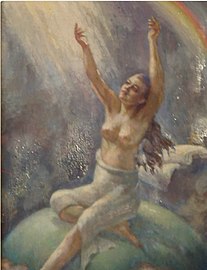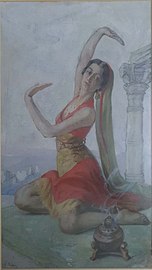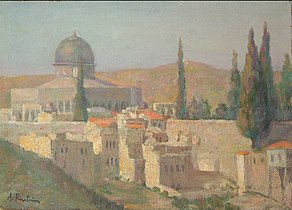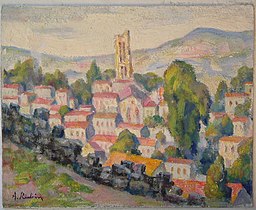Albert Rubin
A major contributor to this article appears to have a close connection with its subject. (August 2022) |
Albert Rubin | |
|---|---|
אלברט רובין | |
 Albert Rubin Painting James Sanua 1910 | |
| Born | Avraham Rubin 10 July 1887 |
| Died | 31 May 1956 (aged 68) |
| Resting place | Cimetière parisien de Bagneux |
| Education | The Bezalel Academy of Art and Design in Jerusalem, Ecole des Beaux-Arts |
| Occupation(s) | painter, Sculptor and artist |
| Website | www |


Albert Rubin (10 July 1887 – 31 May 1956) was a Bulgarian-born Jewish painter, sculptor, graphic artist and illustrator. He was selected for the first class of Bezalel Art School, and later established his artistic career in Paris, where he lived and presented his work.[1]
Biography
Albert (Avraham) Rubin was born in Sofia, the capital of Bulgaria. His father, Nissim Rubin, who mastered several languages, worked as an interpreter for tourists and diplomats. He had two brothers and three sisters. To help support the family, Rubin left school to become a carpenter’s apprentice. In his free time, he sculpted in wood. In 1903, urged by Boris Schatz, a family friend and the "father of Israeli art", he began studying painting and sculpture at the National Academy of Arts in Sofia.[2] When Theodor Herzl visited Sofia, Rubin was commissioned to paint his portrait.
In 1905, the Seventh Zionist Congress in Basel reached a decision to establish an art school in Palestine. A group of thirty young artists from all over Europe were to be selected to form the first class. Rubin, then 19 years old, applied and was immediately accepted.[3]
Rubin attended Bezalel for three years, 1906-1909, returned briefly to Bulgaria, and then moved to Paris, where he studied at the Ecole des Beaux-Arts until 1917. Meanwhile his mother died, and the family joined him in Paris. His father, who worked as night watchman, died in a work accident in January 1914, leaving Rubin to care for his five siblings.
During World War I, he served in the French army, teaching art to Belgian and French soldiers.[4] In 1931, he was accidentally blinded in one eye but continued to paint.[5]
In 1933, he married and had two children, a daughter, Sylvia, and a son, Claude.[6] During World War II, when the Nazis invaded France, he was forced to go into hiding for long periods of time. After the war, Rubin helped found the Association of Jewish Artists and Sculptors in France.
in May 1956, when he was 68, Rubin was hit by a car in Paris and died of his injuries. He was buried in Cimetiere parisien de Bagneux in a family plot beside his father. His daughter Sylvia Chetrit immigrated to Israel in 1969.
Art career
In early 1906, Rubin and his family arrived to Jerusalem. He began his studies in Bezalel Art School on 1 March 1906. He was placed in an advanced class. [ Among his teachers were Ephraim Moses Lilien and Samuel Hirszenberg. He painted and sculpted the landscapes of the land of Israel, especially the ones of Jerusalem. Several of his sculptures remained at Bezalel, among them two busts of children for which he used his younger brothers as models.
In the fall of 1909, he left for Paris to continue his art education. To make ends meet he sold all the paintings he had brought with him and began to work as a street artist, creating sidewalk drawings in chalk. He was accepted at the Ecole des Beaux Arts in Paris and received a scholarship, thanks to the intervention of Baron Rothschild. One of his first teachers was Fernand Cormon.[5] He was a candidate for the Prix de Rome, but turned out to be ineligible because he was not a French citizen. He was invited to join the staff of Athenee de France, a respected art magazine, after exhibiting his dual portrait of Sheikh Abu-Nadra (pen name of Yaqub Sanu, an Egyptian Jewish playwright and journalist).
After serving in the French army in World War I, he received French citizenship. He was accepted to the Societe des Artistes Francais in 1914. From then on, he exhibited his work at its annual exhibition, Salon des Artistes Francais, and was lauded in the newspapers for his pastels and oils.[5] Later, he became a sought-after portrait painter, noted for his unique style.[7]
Gallery
-
Nude model,
oil on canvas,
32X21 -
Peace of Mankind, 1940,
oil on wood,
46.5X30 -
The Indian dancer,
watercolor on cardboard,
43X26
-
Portrait of a redheaded woman in profile, 1935,
Pastel on cardboard,
39.5X30 -
Portrait of an older man,
oil on canvas,
35X27 -
Portrait of Mr. R from Madagascar, 1951,
watercolor on cardboard,
56.5X47 -
The woman with the pendant,
Crayons on paper,
13.5X8.5
-
Al-Aqsa Mosque, 1906,
oil on wood,
61X46 -
French village, 1936,
oil on cardboard,
24X19 -
Port in Nice France, 1930,
oil on cardboard,
76X56 -
The Blue Lake in Switzerland, 1936,
oil on cardboard,
61.5X50.5
Awards and recognition
In 1933 and 1950, Rubin was awarded prizes at the Salon des Artistes Francais, an annual exhibition of French artists in Paris. A retrospective of his work was held at the Mishkan Museum of Art at Kibbutz Ein Harod in June–August 2010.[8]
See also
References
- ^ "Portraits: Transition and Beyond - Albert Rubin" (PDF). Pages 39-42. Retrieved 20 August 2020.
- ^ Albert Rubin biography
- ^ ArtBeat: Albert Rubin 1887-1956
- ^ Bidspirit: Albert Rubin 1887-1956
- ^ a b c Information Center for Israeli Art, Israel Museum
- ^ Albert Rubin: Beginnings (Hebrew)
- ^ Portraits from the Past and Beyond: A New Exhibit at the Municipal Gallery
- ^ Mishkan Museum of Art, Ein Harod, “Beginnings”
Further reading
- curators, Galia Bar Or and Doron J. Lurie text editing, Edith Heiman English translation and editing, Arlene and Jerry Aviram, Uri Bruck Albert Rubin, beginnings (exhibition catalogue), En Harod (Israel), 2010
- Sylvia Chetrit; Claudine Ratié; François Lefebre, Albert Rubin : 1887-1956, ISBN 2952623708, French
- Albert Rubin, peintre de la réalité, French












